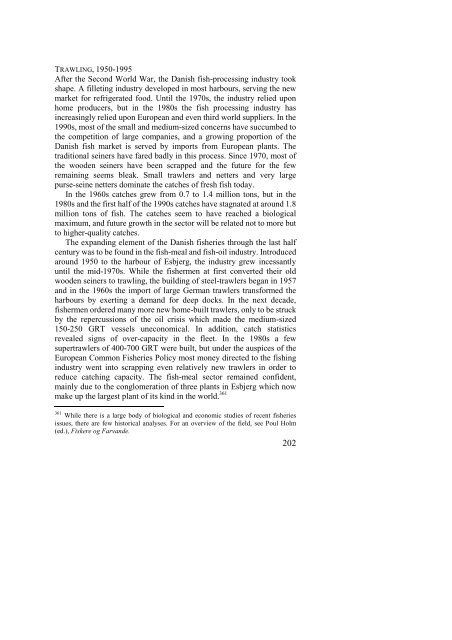The North Atlantic Fisheries, 1100-1976 - University of Hull
The North Atlantic Fisheries, 1100-1976 - University of Hull
The North Atlantic Fisheries, 1100-1976 - University of Hull
Create successful ePaper yourself
Turn your PDF publications into a flip-book with our unique Google optimized e-Paper software.
TRAWLING, 1950-1995<br />
After the Second World War, the Danish fish-processing industry took<br />
shape. A filleting industry developed in most harbours, serving the new<br />
market for refrigerated food. Until the 1970s, the industry relied upon<br />
home producers, but in the 1980s the fish processing industry has<br />
increasingly relied upon European and even third world suppliers. In the<br />
1990s, most <strong>of</strong> the small and medium-sized concerns have succumbed to<br />
the competition <strong>of</strong> large companies, and a growing proportion <strong>of</strong> the<br />
Danish fish market is served by imports from European plants. <strong>The</strong><br />
traditional seiners have fared badly in this process. Since 1970, most <strong>of</strong><br />
the wooden seiners have been scrapped and the future for the few<br />
remaining seems bleak. Small trawlers and netters and very large<br />
purse-seine netters dominate the catches <strong>of</strong> fresh fish today.<br />
In the 1960s catches grew from 0.7 to 1.4 million tons, but in the<br />
1980s and the first half <strong>of</strong> the 1990s catches have stagnated at around 1.8<br />
million tons <strong>of</strong> fish. <strong>The</strong> catches seem to have reached a biological<br />
maximum, and future growth in the sector will be related not to more but<br />
to higher-quality catches.<br />
<strong>The</strong> expanding element <strong>of</strong> the Danish fisheries through the last half<br />
century was to be found in the fish-meal and fish-oil industry. Introduced<br />
around 1950 to the harbour <strong>of</strong> Esbjerg, the industry grew incessantly<br />
until the mid-1970s. While the fishermen at first converted their old<br />
wooden seiners to trawling, the building <strong>of</strong> steel-trawlers began in 1957<br />
and in the 1960s the import <strong>of</strong> large German trawlers transformed the<br />
harbours by exerting a demand for deep docks. In the next decade,<br />
fishermen ordered many more new home-built trawlers, only to be struck<br />
by the repercussions <strong>of</strong> the oil crisis which made the medium-sized<br />
150-250 GRT vessels uneconomical. In addition, catch statistics<br />
revealed signs <strong>of</strong> over-capacity in the fleet. In the 1980s a few<br />
supertrawlers <strong>of</strong> 400-700 GRT were built, but under the auspices <strong>of</strong> the<br />
European Common <strong>Fisheries</strong> Policy most money directed to the fishing<br />
industry went into scrapping even relatively new trawlers in order to<br />
reduce catching capacity. <strong>The</strong> fish-meal sector remained confident,<br />
mainly due to the conglomeration <strong>of</strong> three plants in Esbjerg which now<br />
make up the largest plant <strong>of</strong> its kind in the world. 361<br />
361 While there is a large body <strong>of</strong> biological and economic studies <strong>of</strong> recent fisheries<br />
issues, there are few historical analyses. For an overview <strong>of</strong> the field, see Poul Holm<br />
(ed.), Fiskere og Farvande.<br />
202















